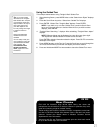
20
Important Note:
While performing the
automatic tracking
procedure, only use the
Arrow keys to move the
telescope. Once the
telescope has been
aligned, do not loosen
the telescope’s vertical or
horizontal locks (
6 and 9,
Fig. 1) or move the base
manually or alignment
will be lost.
When the procedure is performed correctly, "Alignment Successful" displays. If
Autostar does not display this message, perform this procedure again.
NOTE: Autostar locates alignment stars based on the date, time and loca-
tion entered. The alignment stars may change from night to night. All that
is required is for the observer to center the selected stars in the eyepiece
when prompted.
Observe a Star using the Automatic Tracking Feature
In this example, the Autostar Arrow keys are used to find a star and then Autostar's
tracking feature automatically keeps the star centered in your
telescope's eyepiece. Make sure you have initialized and aligned your telescope
before you try out this feature (see pages 18 and 19).
1. Once you’re telescope has been aligned, “Align Successful” and then “Select Item:
Object” display. Push the Scroll Up key once and “Select Item: Setup” displays
2. Press ENTER. “Setup: Align” displays.
3. Press the Scroll Down key repeatedly until "Setup: Targets" displays. Press
ENTER.
4. "Targets: Terrestrial" displays. Press one of the Scroll keys once. "Targets:
Astronomical" now displays.
5. Use the Arrow keys (
5, Fig. 2) to locate a bright star in the night sky. Use the
viewfinder (
2, Fig. 1) to help line up on the star. You may choose any unob-
structed, bright star for the purposes of this example. Use Autostar's Arrow keys
to center the star in the eyepiece. Once the star is centered, press ENTER to
select "Astronomical." The telescope's tracking motors then engage. It may take
the tracking motors several seconds to begin tracking. When they do, it may be
necessary to once again center the star in the eyepiece. The tracking motors will
then keep the star you have chosen in the center of the eyepiece.
6. Press and hold the ENTER key for a few seconds and then release to stop track-
ing. You may repeat the procedure to locate another star or object using the
Arrow keys. Then press ENTER to re-engage the tracking motors.
Go To Saturn
After performing the Easy Align procedure, the motor drive begins operating and the
telescope is aligned for a night of viewing. Objects in the eyepiece will maintain their
position even though the Earth is rotating beneath the stars.
This exercise demonstrates how to select a celestial object, the planet Saturn, for
viewing from Autostar’s database.
NOTE: Saturn is not visible the entire year and you may need to choose
another object from Autostar's database; however, the procedure, as
described below, remains the same. If Saturn (or any other object) is not
currently visible in the sky, Autostar displays “Below Horizon.”
1. After the telescope is aligned, “Select Item: Object” displays. If “Select Item:
Object” is not displayed on your handbox, keep pressing MODE until it does dis-
play. Press ENTER.
2. “Object: Solar System” displays. Press ENTER.
3. “Solar System: Mercury” displays. Keep pressing the Scroll Down key until “Solar
System: Saturn” displays (or you may choose another object from the Solar
System list if Saturn is not visible).
4. Press ENTER. “Calculating” displays. Then “Saturn” and a set of coordinates
displays. Note that Saturn’s (and other planets’) coordinates change throughout
the year.
5. Press GO TO. “Saturn: Slewing...” displays and the telescope slews until it finds
Saturn. You may need to use the Arrow keys to center Saturn precisely in the
eyepiece. Autostar then automatically moves the telescope so that it "tracks"
Saturn (or whatever other object you may have chosen); i.e., Saturn remains
centered in the eyepiece.


















